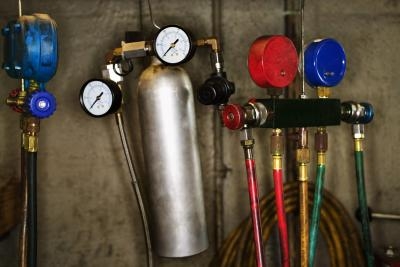
Air conditioning refrigerant is dangerous to the environment, especially the older R22 variety, also known as freon. An environmentally friendlier refrigerant, called R410A, is now being used to replace R22. However, many automotive air conditioning units still use R22, and it is against the law to discharge it into the atmosphere. R22 fluid may be used if the existing system uses R22, until January 1, 2020, when R22 becomes illegal. Unlike the past, when A/C fluid was openly discharged into the air, today's air conditioning maintenance equipment allows the fluid to be properly collected and recycled.
Attach the manifold air gauges to your air conditioning system. Connect the blue hose to the low-pressure valve, and the red hose to the high-pressure valve. The hose attachments connect to the valves by hand. As many A/C systems differ in configuration, consult the repair manual for your system to locate the high- and low-pressure valves.
Attach the yellow hose to the vacuum pump. Once the pump hose is connected, connect the recycling container to the pump using the hose provided with the container. Open the collection cylinder valve
Close the high and low gauges by turning the red and blue knobs to the off position. Start the vacuum pump and open the high- and low-pressure gauges.
Run the pump for approximately 30 minutes. When complete, turn the vacuum pump off and close the high and low pressure valves by turning the red and blue knobs.
Close the collection cylinder valve to keep the refrigerant from escaping. Disconnect all the hoses. Return the cylinder to an approved air conditioning recycling center, or the auto supply store where the tank was purchased.